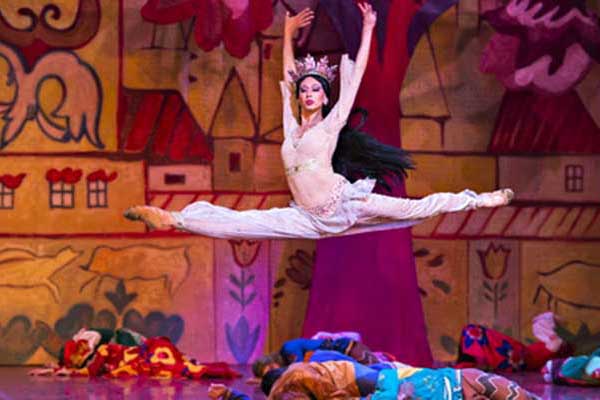
‘Calculating Queen of Shemakha’: Natalia Savelieva in Le Coq d’Or. Photograph: Foteini Christofilopoulou
Le Coq d’Or (The Golden Cockerel) is an opera composed by Rimsky-Korsakov and based on a poem by Pushkin. It opened in Moscow in 1909, the year that Sergei Diaghilev first visited Paris with the troupe of dancers who would become the Ballets Russes. That Paris season, and those that followed, were a sensation. A shrewd judge of the taste of European audiences, Diaghilev presented exotic, folkloric ballets like The Firebird and Scheherazade. To a cultured class already steeped in orientalism he offered a Russia of the imagination, a place of lost kingdoms, magical birds and beautiful princesses.
But by 1914, five years into the project, Diaghilev was in trouble. Mikhail Fokine, the choreographer of the company’s most successful productions, had left in 1912, following a series of bitter disagreements. And in 1913 Diaghilev had dismissed Vaslav Nijinsky, his star dancer and former lover, when Nijinsky married a Hungarian aristocrat who had attached herself to the company. The Ballets Russes had lost its two greatest assets, and Diaghilev badly needed a popular success.
A five-hour phone call eventually won Fokine back. The choreographer went to work, and a new opera-ballet version of Le Coq d’Or had its premiere that summer. The piece was an immediate hit, and it is this production which, a century later, the Russian dancer turned impresario Andris Liepa has restaged. The original score, the libretto and the designs have all survived; only Fokine’s steps have been lost, and these have been reimagined by the choreographer Gali Abaidulov. The result is humming with wit and fun.
Initially, the dramatic music, storybook designs, and broad, folkish choreography combine to slightly bewildering effect. But the production soon begins to make its own, uniquely Russian, kind of sense. The plot, in which a feeble-minded ruler, surrounded by incompetent advisers, is punished for his failure to protect his kingdom from its enemies, would have had considerable satirical resonance in the final years of tsarist rule.
Liepa has set the work on the singers, dancers and orchestra of the Natalia Sats Musical theatre, established in Moscow in 1965 to give children access to classical music culture. The singers are ranged in tiers at the sides of the stage, while the action is performed by the dancers. Oleg Fomin is the idle, blustering King Dodon, Natalia Savelieva is the calculating Queen of Shemakha, all smouldering glances and sultry split jetés, and Pavel Okunev is the Golden Cockerel, a powerful and even threatening presence with his beating wings and stabbing feet. All execute their roles with grand-scale comic precision, as do the corresponding singers (the soprano Olesya Titenko is particularly spectacular as the Queen), while also honouring the score’s lyricism and subtle coloration.
Despite its two-hour length, this is the kind of production to which Muscovites and St Petersburgers routinely take their children. Indeed. a Russian girl in the row in front of me in London, her hair braided and ribboned for the occasion, sat rapt throughout; she can’t have been more than 11. Moscow may not yet be heaven on earth, but it’s hard not to admire a city in which a children’s theatre has its own resident symphony orchestra, opera and ballet company.
Luke Jennings
Star ratings (out of 5)
Le Coq d’Or ****

